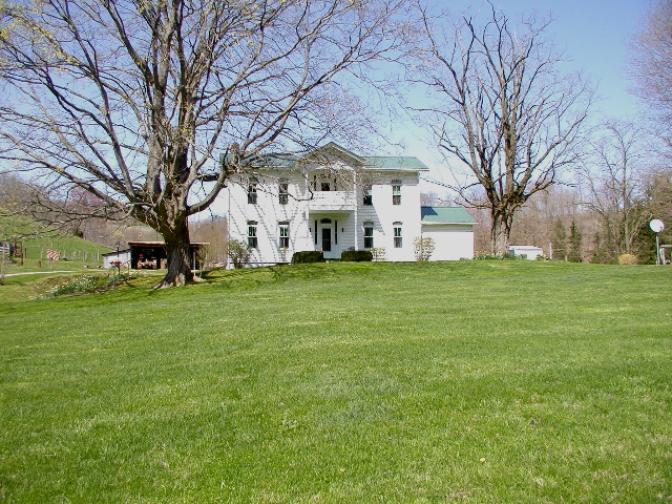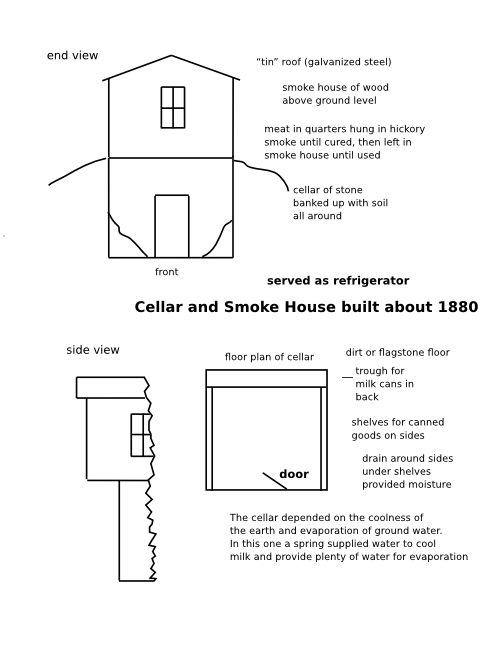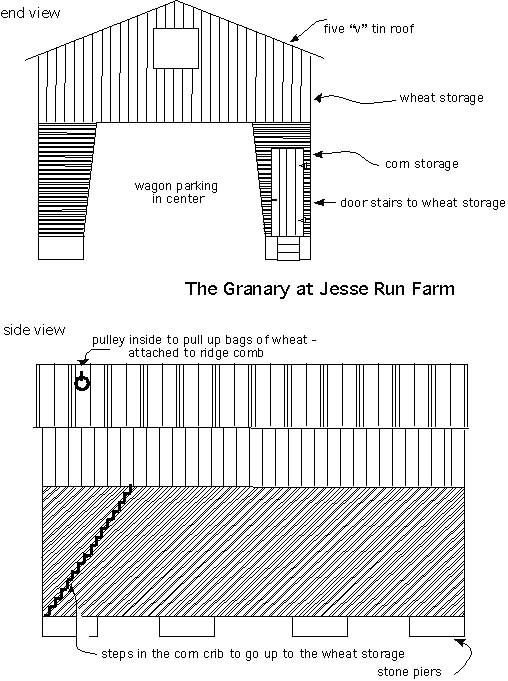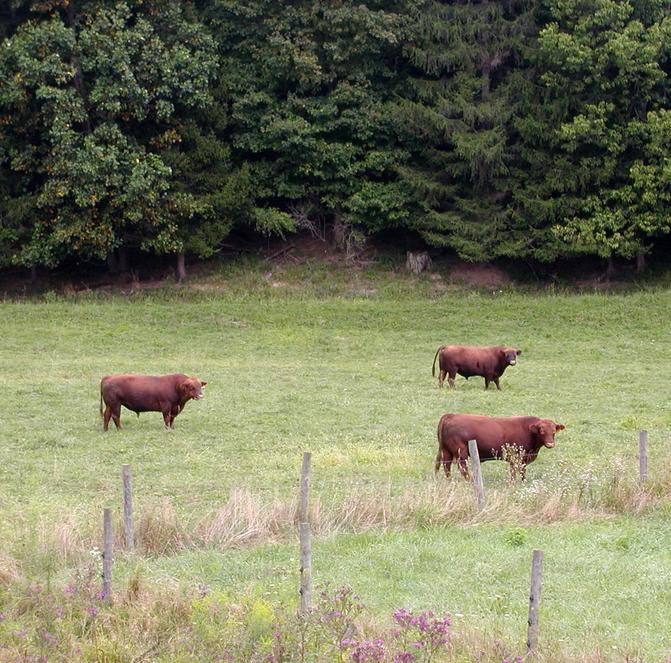
| Next Chapter | Previous Chapter | |
| Chapter 21: Labor | Contents | Chapter 19: Is Farming Boring? |
The Jesse Run farm formerly belonged to Carroll Bond and his uncle, S. O. Bond, the President of Salem College, and their wives. They got it from Dr. Flemming Howell, a physician of Buckhannon, who married Gertrude Bennett, one of the Bennetts of Weston, a very wealthy family, one of the leading families of Lewis County. The Howells were absentee owners, and the last family they had to run the farm were the Barbs, some of whose descendants now live in Weston.
President Bond and his wife, Vennie Haggerty of Sardis, had no children. He and Carroll had many fine purebred Herefords. At one time they owned a bull for which they had paid $10,000, a princely sum in those days, and a hefty price of a bull in 2000, when this is being written. A good bull would cost $2,500 and up today.
Carroll and his wife, Leucretia Thompson of Shinnston, lived on the farm and operated it. They had hired help, one man full time, and others as needed. Dad did some contract work filling silo at the barn which stood diagonally across from the house, somewhat down stream. The last family who worked the farm was the Clarence Collins family, who were still on the farm, in the tenant house, when we arrived in 1962. The Collins family had many children, some of them living now in Weston and Bridgeport.
Carroll worked for the Soil Conservation Service. He dearly loved this work. He was rather easy-going and very sociable. I think the job paid well for the times. He worked at a supervisory level, and he traveled a lot, loved talking to people and influencing them. In those years the SCS was a sort of secular religion - you believed in it, and expected a lot from following the practices they recommended. Carroll and Leucretia had two girls, Dortha and Sylvia, but no son.
By 1962 S. O. and Leucretia were both deceased, and the glut of agricultural production that characterized the 50's to 80's was well developed. There wasn't much profit in beef. The farm was three years into a ten year Soil Bank commitment, a government program to reduce production by taking crop land out of production. Vennie was quite old and Carroll was not able to do much with the farm. Both Mr. and Mrs. Collins were working at the Weston State Hospital and couldn't do much on the farm. Carroll and Vennie decided to look for a buyer.
I want to include a story here that helps to show the character of the farm, relative to the other farmland available in the U. S., and the low demand for land in West Virginia at the time. This story made the rounds at church (the Seventh Day Baptist church at Lost Creek, to which all of us belonged). Dortha had married Paul Green (her first husband) who was from Wisconsin. Carroll offered him the farm as an inheritance, but he turned it down. It was a highly regarded farm in the community, but it didn't look like much to someone from the Midwest! Paul and Dortha went to Wisconsin, where he worked for the Soil Conservation Service and University of Wisconsin Extension Service.
Back to the main story. One day at church Carroll came to Dad and asked, "You don't know anyone who would want to buy a farm, do you?" Dad was surprised, but said, "Let me talk to someone and get back to you."
It was known that Esther and I planned to build a garage apartment where the garage stands at Aunt Lotta's house on the Lost Creek farm, and I would begin farming with Dad. Dad thought he was onto a good thing, but a very large one. He wanted to help sister Lou and Ward Maxson, her husband, as well as Esther and I. He suggested we go into it in partnership. Lou wasn't much interested in farming. Ward was a physician with a specialty in obstetrics, which was very demanding, but he liked the idea and so when Dad returned to Carroll that was the way it was set up - four of us to buy the farm.
Carroll was pleased to be selling to SDB's. It was understood I would do the farming, and the roll to be played by Ward was not very clear. Sunny Rogers wrote the sale contract, and that was the only document there was. No business plan defining responsibility of the partners, which would be de rigueur in today's business climate, or even then in the Midwest at the time, where they were doing more of this sort of thing.
The sale price was $21,000 for 515 acres. We paid another thousand for an 8N Ford tractor (Carroll had maintained two at a time to run the farm), and an old WWII jeep that was equipped to pull a plow. The tractor was completely worn out, and the jeep had been run in 2 nd gear, low range, so much that gear could not be used. We had a land contract. That means the sellers extended credit and got the interest, rather than borrowing from a third party. The 55 acres of meadow was in Soil Bank, and the payment was $1069 a year for the next six or seven years. The payment on the farm was $2000 annually, interest and principal.
You couldn't get more than $20,000 for any piece of property then. There was a large house and 14 acres near Salem for sale for $20,000. Many farms were $20,000.
The house needed paint and eve spouts. It had a coal furnace. Esther and I moved in on a summer time only basis. I was teaching at Salem College, and she was completely occupied with the children. The house had been occupied previously by tenants who worked for the Soil Conservation Service, but it had been empty for five years or so. Fortunately the roof was very good galvanized stuff, of the type called standing seam. This type of roof does well when painted every three to five years with asphalt. There had been a hiatus, but we promptly had it painted, and it lasted 38 more years, until 2000, when it was replaced with another standing seam metal roof, put on with screws. Many times the old roof was painted by the Riffle family from Jane Lew.
(Illustration 20-1)

The old house (built in 1872 or '73) as it appears today in winter
Carroll had done minimum maintenance, painted the roof and had placed in the toilet bowls antifreeze made with methanol (a type of antifreeze that was becoming rare) rather than ethylene glycol (so called permanent antifreeze). He told me to use methanol, because ethylene glycol would form layers rather than mixing with the water in the traps. The basement was empty except for the eight bricks that were used to hold the washer and drier of the previous tenants up off the floor. There was a lot of stuff in the house that had to be thrown away, particularly in the front room on the left, which had served as Carroll's office. We didn't have a crib, so I fixed one for Paul in the corner between the chimney in Carroll's old office and the front wall. It was a little large, but sufficed.
The honest truth is I almost had to drag my wife, Esther, to come over to Jesse Run. The interstate had not been built, and it seemed to be away out in the country. There were five other families on Jesse Run. Now there must be sixty.
In two years we moved over full time. I really did have to drag Esther then. We had free gas, but the house was so open it would not begin to heat it. When we needed coal a friendly truck driver would back up to the basement window near the coal bin and dump his load. All I had to do was shovel it in. I would let the driver hunt in deer season, and that's all it cost.
Leucretia, Carroll's wife, had a terrible arthritis problem. The house had to be warm in the winter, and a coal furnace with a good supply of coal was the most practical guarantee of comfort. There was a small shovel in the basement when we came, eight inches square, I called "the ladies shovel." Esther wouldn't touch it or any other shovel. That's what you get if you marry a parsonage-bred girl! In later years Esther did a lot of shoveling in flower gardens, though. After acculturation.
Carroll had a locust plantation on the hill next to the farm. He expected to sell the locust timber to the State Road Department for guardrail posts. At the time they were planted, guard rails utilized locust posts every few feet with two or three heavy cables threaded through holes in the individual posts, secured at the ends. Metal guardrails came in before we bought the place, so the trees were never sold for that purpose. My mother, Evaleen K. Bond, suggested the name of the farm from this plantation: Locust Hill Farm.
(Illustration 20-2)

Near the house was a cellar and smoke house. The meat smoking process is traditional. Before the turn of the century all farms had a cellar dug into the earth with a smokehouse above the cellar, which also served as a larder or storage place for the smoked meat. Smoking is done more as a flavoring than as a preservative, but I imagine that the smokehouse atmosphere would have discouraged insects in the old days.
The rocks from it went into walkways, etc. The cellar would have had a store house over it originally, but that (Illustration 20-2 above.) was long gone, not even traces of rotting wood.
There was also a granary, combining corn cribs on the sides and storage for small grains in the second story, which stood between the house and the horse barn. (Both the cellar-smokehouse and the granary are types that were common when they were built.)
(Illustration 20-3)

The corncribs were elevated off the ground about a foot by stones. They were made of 1 x 3 inch slats over 2 x 4's. They were about three feet wide at the bottom and perhaps four at the top. The outside was vertical, and the inside was slanted in about a foot at the top, to serve as a brace against lateral forces. Slats on the outside were horizontal, and those on the inside slanted about forty-five degrees, again for bracing. There were stairs in the crib on the right leading to the second floor. There the floor was solid, and so were the sidewalls and ends.
There was a hole in the floor and a pulley above it to hoist bags of grain into the loft. It had a very good galvanized roof, five v-seam. The whole thing was about 20 feet long, perhaps 16 wide. You could pull a wagon in out of the rain and unload or store a wagon in the space.
It was a truly inspired design, all native materials, except the galvanized roof, well braced for the load it had to bear, open to the wind for drying. The really cute part is the rat and mouse prevention. The corncribs were near the ground. When they had ear corn in place, the mice and rats could readily get into the crib - but so could snakes, primarily blacksnakes. The bags of small grain were far enough off the ground they were relatively well protected by the open spaces and snakes in the corn.
A lot has been done with the house over the years. Carroll and Leucreta put the basement under the house, took out the chimney on the right side and put in a coal furnace - those were popular improvements in the 40's - and we put an addition on the back, including the basement garage in 1992. We closed in the east facing porch for a study and put on two decks. And did a lot in the interior. The excavation for the addition was dug out by the people to whom we sold the limestone for the interstate highway, sort of a fringe benefit. (More on mining below)
Esther and I got two and a half acres with the house. Slowly our partnership herd built up, our machinery got better, and what looked like an immense farm at the beginning seemed to get smaller. We have never done any farming on the steep slopes across from the farmhouse. Carroll and Ressie used it for pasture, but much of it is too steep to be worked by Ford 8N tractors, so it was grown up beyond use by the time we got the farm.
My sister Lou and Ward were divorced. It is a long story in its self, too unhappy to be told here. Suffice it to say she had a long serious bout with sickness before, during and after the divorce. Ward bought her interest in the farm, as part of the divorce settlement. I had no knowledge of what was going on until it was over. Needless to say, the divorce placed a strain on relations with other members of the family, since I continued with Ward. However, since Ward seldom put money into the farm, and never any labor, seeing it entirely as an investment in the growth in value of the farm, there was no significant change in operations. He would cosign for borrowed money for investment. I would do the work and pay the loans off. If I made a dime, half of it was his, if I lost a dime I had to figure how to get it back all by myself. In other words, I absorbed all the risk as well as doing all the work and planning. This is what you are likely to get in setting up a partnership if you don't work with a business savvy consultant or a business savvy lawyer. We talked some, but less as the years wore on.
The Ray Smith place came up for sale and Ward decided to buy it in May 1977. Along with the farm Ward got much of the equipment Ray had used, including a John Deere 2640 tractor (72 horsepower), a model 3000 Ford tractor with dual tires loaded , a Vermeer 504C bailer and a Matthews Rotary Scythe which was put into the farm operation. We had a model 3000 that belonged to Esther and me, an 8N Ford tractor and a Rotary Scythe to cut hay. The Smith acquisition provided our first round bailer.
I was now operating the home farm on Jesse Run, 515 acres, the Lost Creek farm, 160 acres, and the Smith place, 240 acres. None of it was as clean as I would wish, but it didn't grow up. I built fence around the Smith place, with the exception of the side with Reverend Tamas on the east of the road, and the side with J. C. Baker and with Christine White, both of which had very good woven wire. The latter was put up while these farms were owned by an earlier generation of Jacksons many years previously. I built all internal fences on the Smith place and a good, secure barn lot. There was an old barbed wire fence along the road which ran from the Hammond house to Christine Jackson's line, which I worked on so much that I could almost claim to have built it.
We never had enough cattle to take advantage of all the grass, but the Smith place had good water, which helped in the late summer. We used little lime and no fertilizer, and managed to pay the lending agency, but had no surplus. Ward did put some fertilizer on a time or two. The boys, Paul, Kurt and Alan, were old enough to help some by this time.
In 1992 Ward announced he wanted to sell the Smith place. Of course I didn't have money to buy it. I
(Illustration 20-4)

Beckton Ranch Red Angus Bulls in West Virgnia
didn't have a cent loose then, never have - assets, but no cash. It was purchased by Pete Bleigh and Sharon Kay Bleigh. Pete's brother died with a large insurance payoff, Pete moved in with his widow and bought the farm. I continued with the Jesse Run farm and the Lost Creek farm, never thinking Ward would want to pull out of the Jesse Run farm. Then in 1994 he announced he wanted to sell his interest in the Jesse Run farm - for a very substantial sum! The price wasn't unreasonable, for half interest, but how could I come up with that kind of money? I thought very hard about this for months.
Ward and Lou had been fighting for years, since the divorce, and all parties wanted to get it settled. I tried to get a solution to Lou's problem worked in, too. My first proposal was for him to give Lou his interest, and I would trade her my interest in the Lost Creek farm and money for Ward's interest in the Jesse Run farm. That wouldn't work because of tax considerations - Lou would have to pay tax and I would have to pay tax on the same farmland. Finally, with the help of Steptoe and Johnson, Ward gave the land tax-free to the three Maxson children, Sheryl, Phil and David. They traded it to me in return for my interest in the Lost Creek farm (at a time I had inherited one-sixth, but not the other sixth - good lawyers can do this sort of thing, you know). They also got a good chunk of boot, in the form of notes, at a rate between what they could earn on their investment and what I would have to pay if I borrowed the money, payments running over the next decade or so.
So, at this writing, in 2000, Esther and I own the farm but have several years left to pay off the notes. Anyway, Lou's heirs got the Lost Creek farm. Which suited me just fine.
Aside A shoe story. One day when I was still teaching full time at Bridgeport High School, I decided that I needed a new pair of "clod hoppers." This was the family way of referring to the traditional heavy shoes that men wore in the fields. They had heavy soles and came up over the ankles to provide support and protect the ankles from briers. Esther, my wife, gave me a price which I thought was way too high, but when I got to the stores, her estimate proved about right. I found one rugged pair, foreign manufacture, marked down for close out, that was about one-third the price of others. They seemed sturdy, so I bought a pair.
A few days later, while I was teaching, I looked back the aisle, and low and behold, there was a shoe of the same manufacture on one of the girls! I knew the girl well and knew this could not be out of style. When I was a kid even the poorest, lowest socioeconomic ranking girls in the class would have been "mortified" to wear a pair like that. Times change and styles change! Big-footed women! Bah!
| Next Chapter | Previous Chapter | |
| Chapter 21: Labor | Contents | Chapter 19: Is Farming Boring? |
Copyright © 1998, 2006, 2008, 2011 S. Tom Bond (stombond at hughes.net)